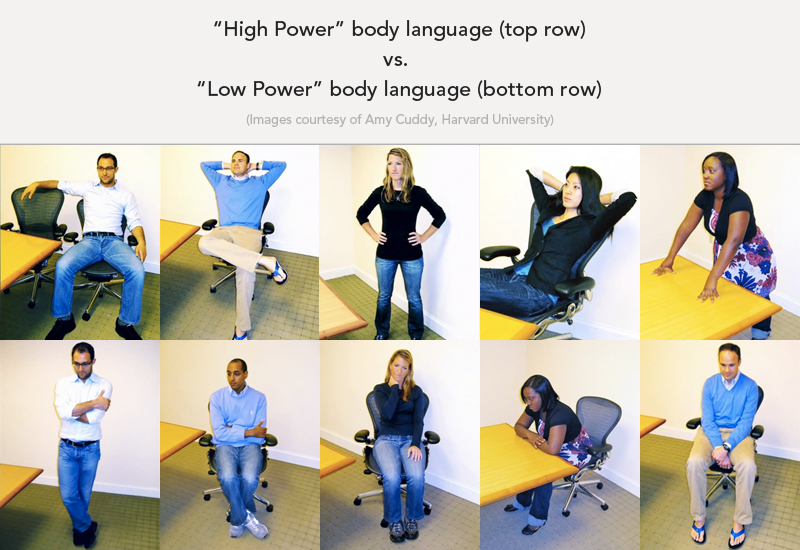 Do you need a quick confidence boost?
Do you need a quick confidence boost?
Try the classic “Wonder Woman” pose for 2-minutes (named after the comic book character). Yes! It works for men too. Use it before you give a talk, go on stage, or walk into a job interview.
As an Associate Professor at Harvard Business School and a social psychologist, Amy Cuddy researches presence. She has identified high power poses that are open and relaxed and low power poses that are closed and guarded. (See picture above.) High power poses increase testosterone (increase confidence and risk-tolerance) and decrease cortisol (stress hormone). You can find her research article online.
What is PRESENCE?

Amy Cuddy has collected responses from all over the world by posting the question online. Here are some examples from her book:
Presence is removing judgment, walls, and masks so as to create a true and deep connection with people or experiences.
—Pam, Washington State, USAPresence is loving people around you and enjoying what you do for them.
—Anonymous, CroatiaPresence is being myself and keeping confident, whatever happens.
—Abdelghani, Morocco
The answers vary widely, and “presence” means different things to different people. While most of us may not know how to define “presence,” we know it when we feel it or see it. In addition, we certainly can tell you when that quality is missing.
“She’s got PRESENCE!”
In her research, Amy Cuddy uses the term “PRESENCE” to refer to when we “show up fully” manifesting “confidence without arrogance.” Presence in this definition is always GOOD. You might hear someone say, “They really have presence!” Depending on the context, this can mean different things: stage presence for performers, bedside manner for physicians, therapeutic presence for therapists.
In contrast, other researchers use the term “presence” more generally as “how you show up.” In this definition, presence can be judged as “good” or “bad.” This is a different way to use the word. You must understand how Amy Cuddy uses the word in order to understand her research.
Amy Cuddy clarifies the quality of “presence” in her book.
Presence … is the state of being attuned to and able to comfortably express our true thoughts, feelings, values, and potential. That’s it. It is not a permanent, transcendent mode of being. It comes and goes. It is a moment-to-moment phenomenon.
Presence emerges when we feel personally powerful, which allows us to be acutely attuned to our most sincere selves. In this psychological state, we are able to maintain presence even in the very stressful situations that typically make us feel distracted and powerless. When we feel present, our speech, facial expressions, postures, and movements align…. It’s what makes us compelling. We are no longer fighting ourselves; we are being ourselves. Our search for presence isn’t about finding charisma or extraversion or carefully managing the impression we’re making on other people. It’s about the honest, powerful connection that we create internally, with ourselves.
The kind of presence I’m talking about comes through incremental change…. achieving a state of psychological presence that lasts just long enough to get us through our most challenging, high-stakes, a-lot-is-on-the-line situations, such as job interviews, difficult conversations, idea pitches, asking for help, public speeches, performances, and the like.
Presence is about the everyday. It’s even, dare I say, ordinary. We can all do it; most of us just don’t yet know how to summon that presence when it temporarily escapes us at life’s critical moments.
—Amy Cuddy, Presence: Bringing Your Boldest Self to Your Biggest Challenges
Learning PRESENCE
By changing body language (such as using the high power poses pictured above) and changing mind-set, the state of PRESENCE can be self-induced. In her book, Amy Cuddy tells her own compelling story and presents her research. She demonstrates the mind-body link: body can affect the mind, and mind can affect the body. PRESENCE comes from feeling EMPOWERED, and from that place we can be our AUTHENTIC selves and SHOW UP FULLY.
While the incremental changes might not be as simple as just “power poses for two minutes,” they are simple incremental mind-set changes that translate into incremental action over time. Acting as if you feel confident and getting a positive response creates confidence. Confidence creates PRESENCE.
In order to feel truly present, the various elements of the self – emotions, thoughts, physical and facial expressions, behaviors – must be in harmony. If our actions aren’t consistent with our values, we won’t feel that we’re being true to ourselves. If our emotions aren’t reflected in our physical expressions, we don’t feel real.
—Amy Cuddy, Presence: Bringing Your Boldest Self to Your Biggest Challenges
She proves that PRESENCE is a skill that can be learned. And that you can “fake it until you make it” or as her inspiring personal story tells us “fake it until you become it.” (Watch her TED talk below.)
